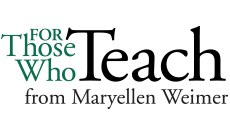We already do give students some choices. We let them choose paper topics, decide what to do for group projects, select subjects for artwork—and we’ve seen them struggle to make those choices. Most students don’t see selecting content as an opportunity to explore an area of interest, but rather an added burden of now trying to figure out what the teacher wants.
 The bulk of what students must learn in a course can’t be their choice. In most fields, they don’t know what they need learn, but are there reasons to give them some choices about content?
The bulk of what students must learn in a course can’t be their choice. In most fields, they don’t know what they need learn, but are there reasons to give them some choices about content?
Here’s a few things to consider.
- Making content choices is part of what’s involved in being an independent, self-directed learner. Mature learners decide what to learn when they discover there’s something they need to know or something about which they need to know more. Sometimes curiosity drives them to the content. There’s a question that can’t be answered, an action that can’t be explained, or an idea that doesn’t make any sense.
- Choosing what to learn involves skill. The content must be identified, questions about it framed, and content boundaries set. Many students lack the ability to do this. They come up with topics that are much too broad, projects that can’t possibly be completed by the due date, or what they decide to do doesn’t match the task they’ve been asked to complete.
- Fortunately, making smarter choices is a skill that develops with practice. The more times the decisions are made, the easier they are to make, especially when there’s feedback and the opportunity to reflect. And with practice comes confidence. The requirement to make choices about what to learn moves students in the direction of reasoned decision-making rather than anguish over the imposition.
- It has the potential to motivate. Getting to choose means getting to control a part of the learning process. If students can move beyond choosing what they think the teacher would like, it becomes a chance to pursue an area of interest or, at the very least, avoid boredom.
- When students make a decision, they’re more likely to own it. Less blame can be put on the teacher if students don’t like what they’re learning. Making the decision about what to learn encourages students to accept more of the responsibility for learning.
What other decisions about what to learn could we give our students? How about these possibilities?
- A choice about the areas of focus in a paper or project. If the paper or project has multiple parts, students could choose to give one of those parts a more prominent role in the paper or project.
- A choice of exam questions. For in-class or online essay questions, each student generates a designated number questions, and the teacher selects one of those questions for the student to answer. The quality of the question becomes part of the grade.
- A choice about what to read. Provided with a collection of readings on a topic, annotated with intriguing highlights, students select which one(s) they will read. Discussion then focuses on integration of the various readings and identification of major themes, issues, or ideas.
- Choice on homework problems. Perhaps an easy, moderate, and challenging set of questions, each worth a different point value, possibly followed by a quiz that exposes anyone who simply copied the answers.
And what about when they don’t make good choices?
Herein lies the main reason teachers are hesitant to let student make choices, not just about what they learn but about any part of the learning process. And that creates a vicious cycle. Without many opportunities to make choices and without much experience doing so, students are ever more likely to make bad choices and teachers are ever more motivated to keep them from making those mistakes that are so common among novice learners.
This dilemma has two possible solutions. Let students make choices about learning where the consequences aren’t so dire, like short essays or in-class group projects. From there move on incrementally to choices that are more challenging. Secondly, a poor choice is an opportunity to learn. Students learn from mistakes when they realize they’ve made one and when they confront alternatives that are better options.
Please be welcome to share below any decisions you let students make about content and how doing so affects their learning.






